Ethical Dilemma in Database Management
VerifiedAdded on 2020/03/16
|11
|3373
|60
Case Study
AI Summary
This case study explores the ethical dilemmas faced by Diane, a consultant designing a database management system. It highlights the conflict between maintaining strong security measures and adhering to client budget constraints. The analysis employs ethical techniques to evaluate the implications of compromising security, the stakeholders affected, and potential solutions. Ultimately, it emphasizes the importance of ethical decision-making in business practices.
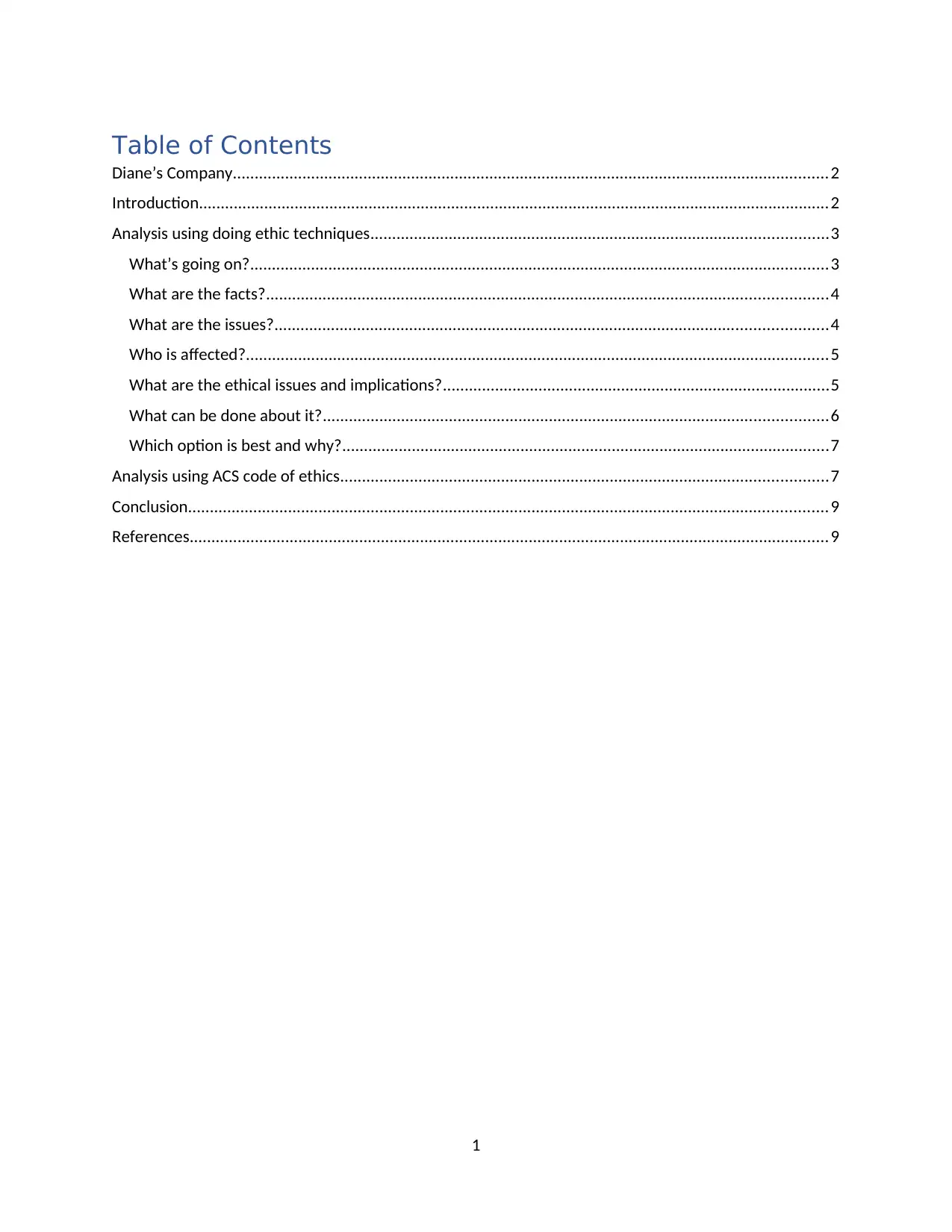
Table of Contents
Diane’s Company.........................................................................................................................................2
Introduction.................................................................................................................................................2
Analysis using doing ethic techniques.........................................................................................................3
What’s going on?.....................................................................................................................................3
What are the facts?.................................................................................................................................4
What are the issues?...............................................................................................................................4
Who is affected?......................................................................................................................................5
What are the ethical issues and implications?.........................................................................................5
What can be done about it?....................................................................................................................6
Which option is best and why?................................................................................................................7
Analysis using ACS code of ethics................................................................................................................7
Conclusion...................................................................................................................................................9
References...................................................................................................................................................9
1
Diane’s Company.........................................................................................................................................2
Introduction.................................................................................................................................................2
Analysis using doing ethic techniques.........................................................................................................3
What’s going on?.....................................................................................................................................3
What are the facts?.................................................................................................................................4
What are the issues?...............................................................................................................................4
Who is affected?......................................................................................................................................5
What are the ethical issues and implications?.........................................................................................5
What can be done about it?....................................................................................................................6
Which option is best and why?................................................................................................................7
Analysis using ACS code of ethics................................................................................................................7
Conclusion...................................................................................................................................................9
References...................................................................................................................................................9
1
Paraphrase This Document
Need a fresh take? Get an instant paraphrase of this document with our AI Paraphraser
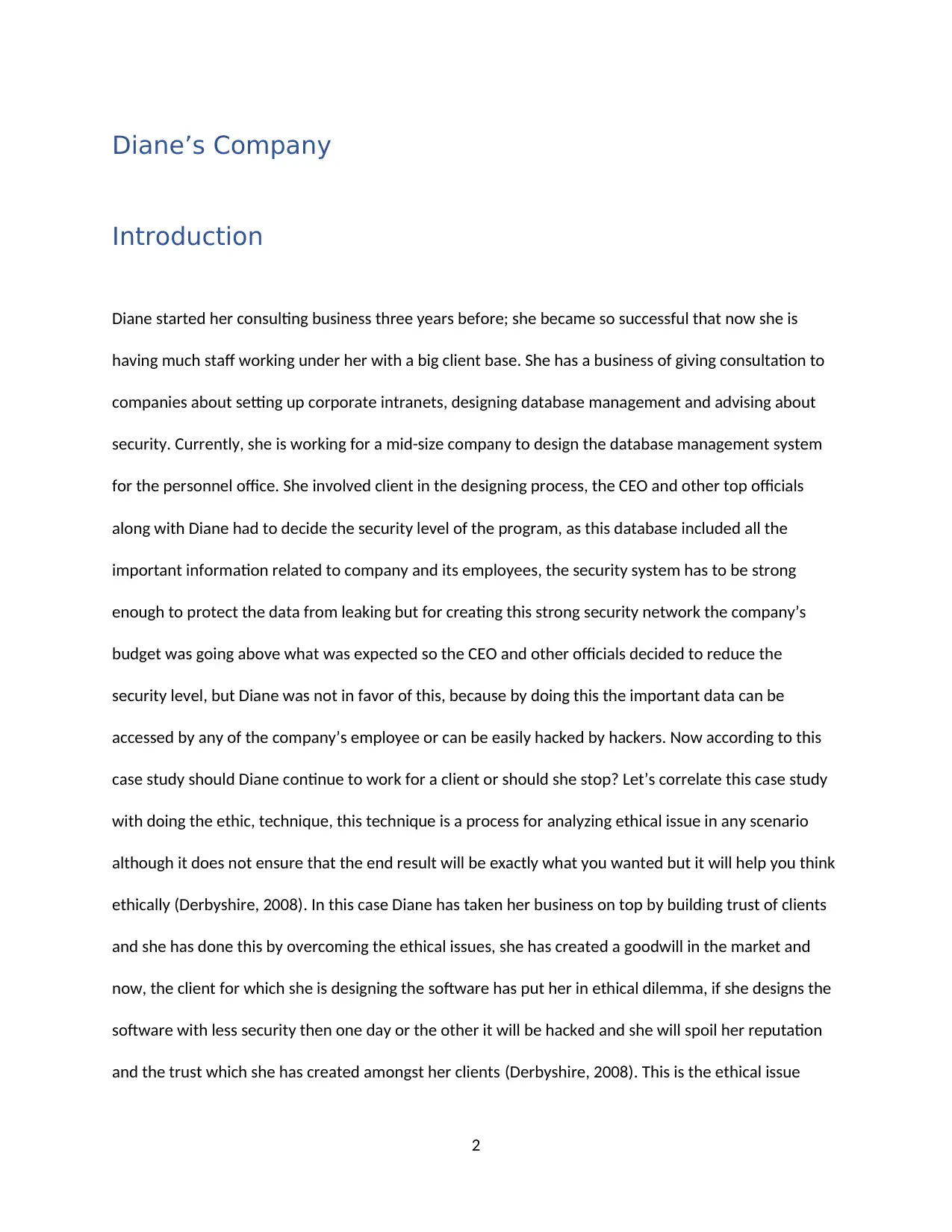
Diane’s Company
Introduction
Diane started her consulting business three years before; she became so successful that now she is
having much staff working under her with a big client base. She has a business of giving consultation to
companies about setting up corporate intranets, designing database management and advising about
security. Currently, she is working for a mid-size company to design the database management system
for the personnel office. She involved client in the designing process, the CEO and other top officials
along with Diane had to decide the security level of the program, as this database included all the
important information related to company and its employees, the security system has to be strong
enough to protect the data from leaking but for creating this strong security network the company’s
budget was going above what was expected so the CEO and other officials decided to reduce the
security level, but Diane was not in favor of this, because by doing this the important data can be
accessed by any of the company’s employee or can be easily hacked by hackers. Now according to this
case study should Diane continue to work for a client or should she stop? Let’s correlate this case study
with doing the ethic, technique, this technique is a process for analyzing ethical issue in any scenario
although it does not ensure that the end result will be exactly what you wanted but it will help you think
ethically (Derbyshire, 2008). In this case Diane has taken her business on top by building trust of clients
and she has done this by overcoming the ethical issues, she has created a goodwill in the market and
now, the client for which she is designing the software has put her in ethical dilemma, if she designs the
software with less security then one day or the other it will be hacked and she will spoil her reputation
and the trust which she has created amongst her clients (Derbyshire, 2008). This is the ethical issue
2
Introduction
Diane started her consulting business three years before; she became so successful that now she is
having much staff working under her with a big client base. She has a business of giving consultation to
companies about setting up corporate intranets, designing database management and advising about
security. Currently, she is working for a mid-size company to design the database management system
for the personnel office. She involved client in the designing process, the CEO and other top officials
along with Diane had to decide the security level of the program, as this database included all the
important information related to company and its employees, the security system has to be strong
enough to protect the data from leaking but for creating this strong security network the company’s
budget was going above what was expected so the CEO and other officials decided to reduce the
security level, but Diane was not in favor of this, because by doing this the important data can be
accessed by any of the company’s employee or can be easily hacked by hackers. Now according to this
case study should Diane continue to work for a client or should she stop? Let’s correlate this case study
with doing the ethic, technique, this technique is a process for analyzing ethical issue in any scenario
although it does not ensure that the end result will be exactly what you wanted but it will help you think
ethically (Derbyshire, 2008). In this case Diane has taken her business on top by building trust of clients
and she has done this by overcoming the ethical issues, she has created a goodwill in the market and
now, the client for which she is designing the software has put her in ethical dilemma, if she designs the
software with less security then one day or the other it will be hacked and she will spoil her reputation
and the trust which she has created amongst her clients (Derbyshire, 2008). This is the ethical issue
2
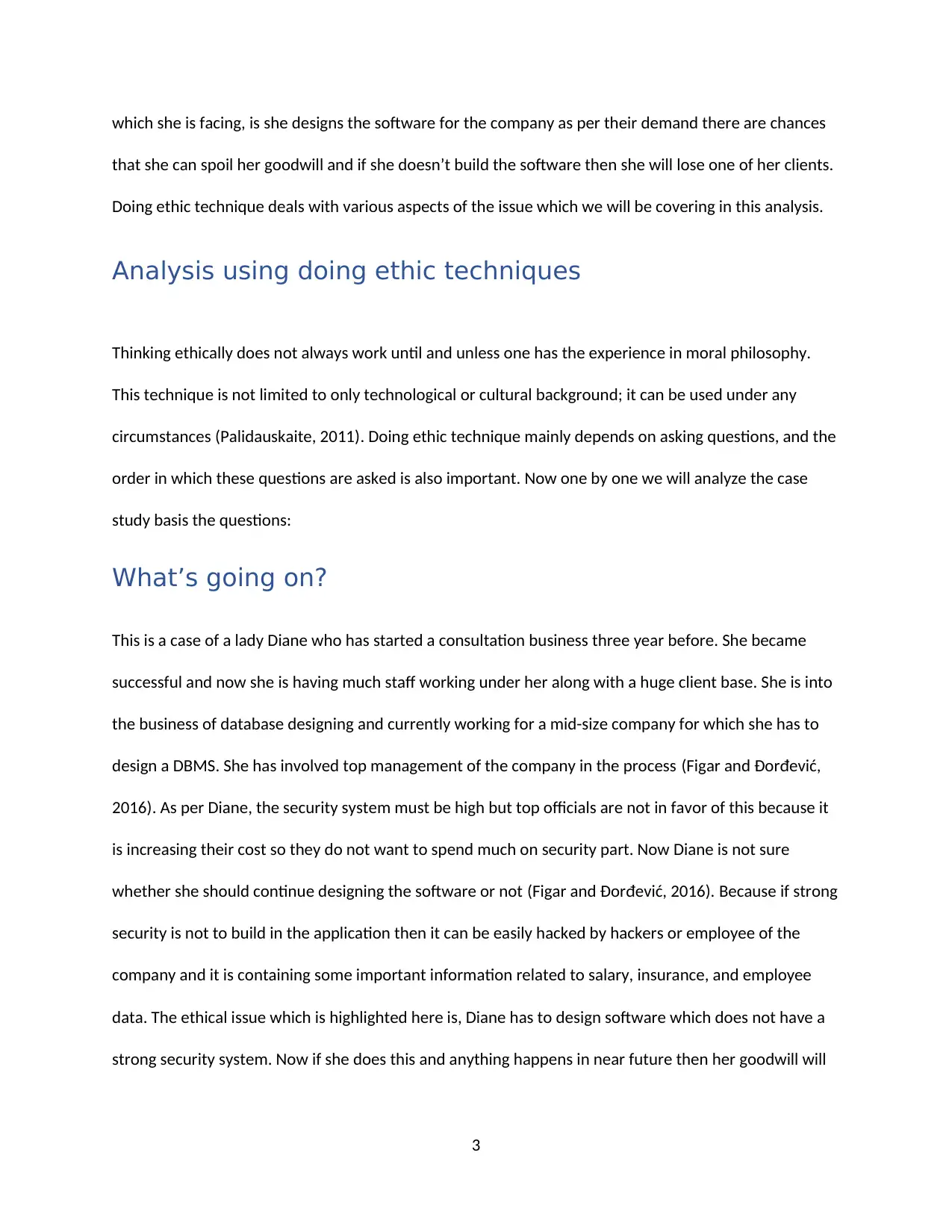
which she is facing, is she designs the software for the company as per their demand there are chances
that she can spoil her goodwill and if she doesn’t build the software then she will lose one of her clients.
Doing ethic technique deals with various aspects of the issue which we will be covering in this analysis.
Analysis using doing ethic techniques
Thinking ethically does not always work until and unless one has the experience in moral philosophy.
This technique is not limited to only technological or cultural background; it can be used under any
circumstances (Palidauskaite, 2011). Doing ethic technique mainly depends on asking questions, and the
order in which these questions are asked is also important. Now one by one we will analyze the case
study basis the questions:
What’s going on?
This is a case of a lady Diane who has started a consultation business three year before. She became
successful and now she is having much staff working under her along with a huge client base. She is into
the business of database designing and currently working for a mid-size company for which she has to
design a DBMS. She has involved top management of the company in the process (Figar and Đorđević,
2016). As per Diane, the security system must be high but top officials are not in favor of this because it
is increasing their cost so they do not want to spend much on security part. Now Diane is not sure
whether she should continue designing the software or not (Figar and Đorđević, 2016). Because if strong
security is not to build in the application then it can be easily hacked by hackers or employee of the
company and it is containing some important information related to salary, insurance, and employee
data. The ethical issue which is highlighted here is, Diane has to design software which does not have a
strong security system. Now if she does this and anything happens in near future then her goodwill will
3
that she can spoil her goodwill and if she doesn’t build the software then she will lose one of her clients.
Doing ethic technique deals with various aspects of the issue which we will be covering in this analysis.
Analysis using doing ethic techniques
Thinking ethically does not always work until and unless one has the experience in moral philosophy.
This technique is not limited to only technological or cultural background; it can be used under any
circumstances (Palidauskaite, 2011). Doing ethic technique mainly depends on asking questions, and the
order in which these questions are asked is also important. Now one by one we will analyze the case
study basis the questions:
What’s going on?
This is a case of a lady Diane who has started a consultation business three year before. She became
successful and now she is having much staff working under her along with a huge client base. She is into
the business of database designing and currently working for a mid-size company for which she has to
design a DBMS. She has involved top management of the company in the process (Figar and Đorđević,
2016). As per Diane, the security system must be high but top officials are not in favor of this because it
is increasing their cost so they do not want to spend much on security part. Now Diane is not sure
whether she should continue designing the software or not (Figar and Đorđević, 2016). Because if strong
security is not to build in the application then it can be easily hacked by hackers or employee of the
company and it is containing some important information related to salary, insurance, and employee
data. The ethical issue which is highlighted here is, Diane has to design software which does not have a
strong security system. Now if she does this and anything happens in near future then her goodwill will
3
⊘ This is a preview!⊘
Do you want full access?
Subscribe today to unlock all pages.

Trusted by 1+ million students worldwide
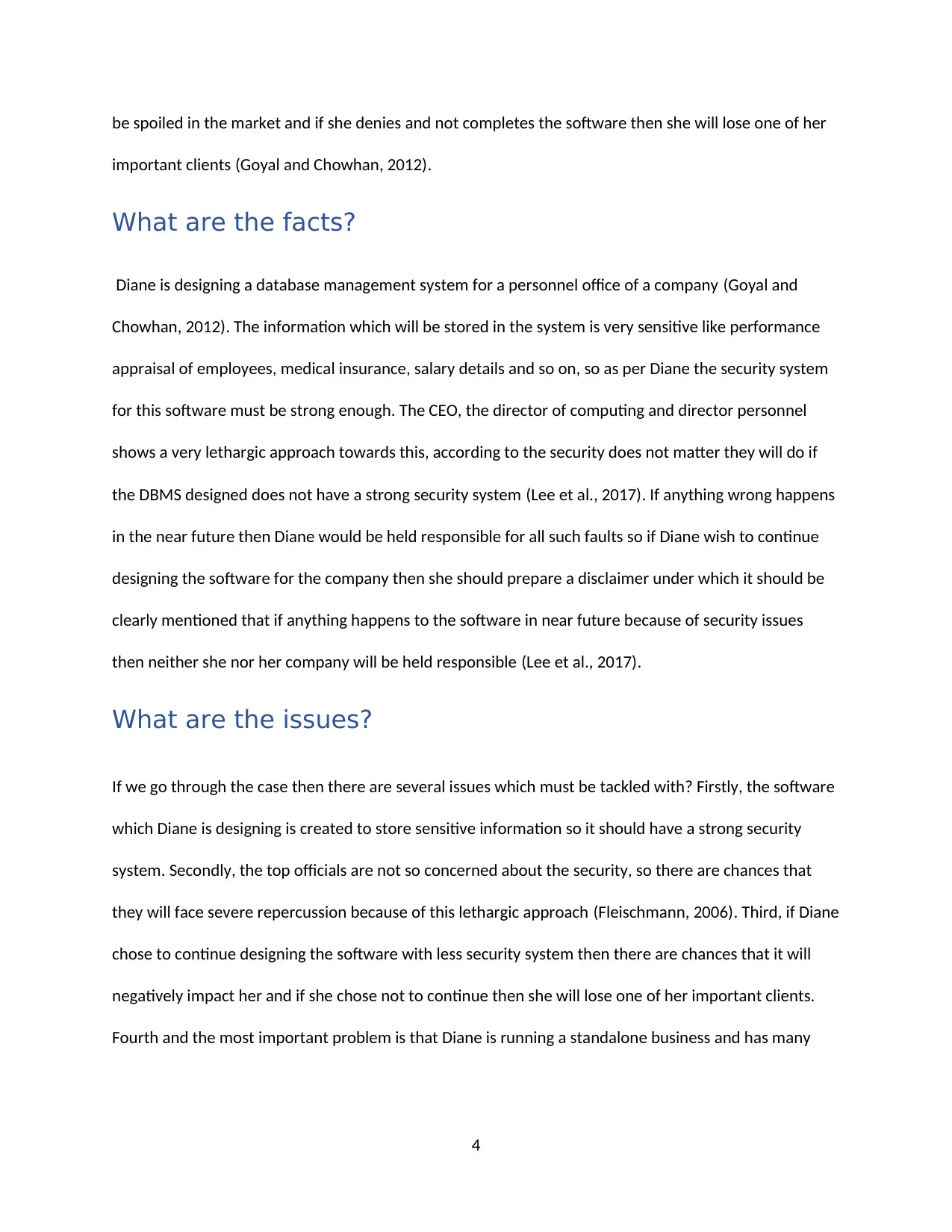
be spoiled in the market and if she denies and not completes the software then she will lose one of her
important clients (Goyal and Chowhan, 2012).
What are the facts?
Diane is designing a database management system for a personnel office of a company (Goyal and
Chowhan, 2012). The information which will be stored in the system is very sensitive like performance
appraisal of employees, medical insurance, salary details and so on, so as per Diane the security system
for this software must be strong enough. The CEO, the director of computing and director personnel
shows a very lethargic approach towards this, according to the security does not matter they will do if
the DBMS designed does not have a strong security system (Lee et al., 2017). If anything wrong happens
in the near future then Diane would be held responsible for all such faults so if Diane wish to continue
designing the software for the company then she should prepare a disclaimer under which it should be
clearly mentioned that if anything happens to the software in near future because of security issues
then neither she nor her company will be held responsible (Lee et al., 2017).
What are the issues?
If we go through the case then there are several issues which must be tackled with? Firstly, the software
which Diane is designing is created to store sensitive information so it should have a strong security
system. Secondly, the top officials are not so concerned about the security, so there are chances that
they will face severe repercussion because of this lethargic approach (Fleischmann, 2006). Third, if Diane
chose to continue designing the software with less security system then there are chances that it will
negatively impact her and if she chose not to continue then she will lose one of her important clients.
Fourth and the most important problem is that Diane is running a standalone business and has many
4
important clients (Goyal and Chowhan, 2012).
What are the facts?
Diane is designing a database management system for a personnel office of a company (Goyal and
Chowhan, 2012). The information which will be stored in the system is very sensitive like performance
appraisal of employees, medical insurance, salary details and so on, so as per Diane the security system
for this software must be strong enough. The CEO, the director of computing and director personnel
shows a very lethargic approach towards this, according to the security does not matter they will do if
the DBMS designed does not have a strong security system (Lee et al., 2017). If anything wrong happens
in the near future then Diane would be held responsible for all such faults so if Diane wish to continue
designing the software for the company then she should prepare a disclaimer under which it should be
clearly mentioned that if anything happens to the software in near future because of security issues
then neither she nor her company will be held responsible (Lee et al., 2017).
What are the issues?
If we go through the case then there are several issues which must be tackled with? Firstly, the software
which Diane is designing is created to store sensitive information so it should have a strong security
system. Secondly, the top officials are not so concerned about the security, so there are chances that
they will face severe repercussion because of this lethargic approach (Fleischmann, 2006). Third, if Diane
chose to continue designing the software with less security system then there are chances that it will
negatively impact her and if she chose not to continue then she will lose one of her important clients.
Fourth and the most important problem is that Diane is running a standalone business and has many
4
Paraphrase This Document
Need a fresh take? Get an instant paraphrase of this document with our AI Paraphraser
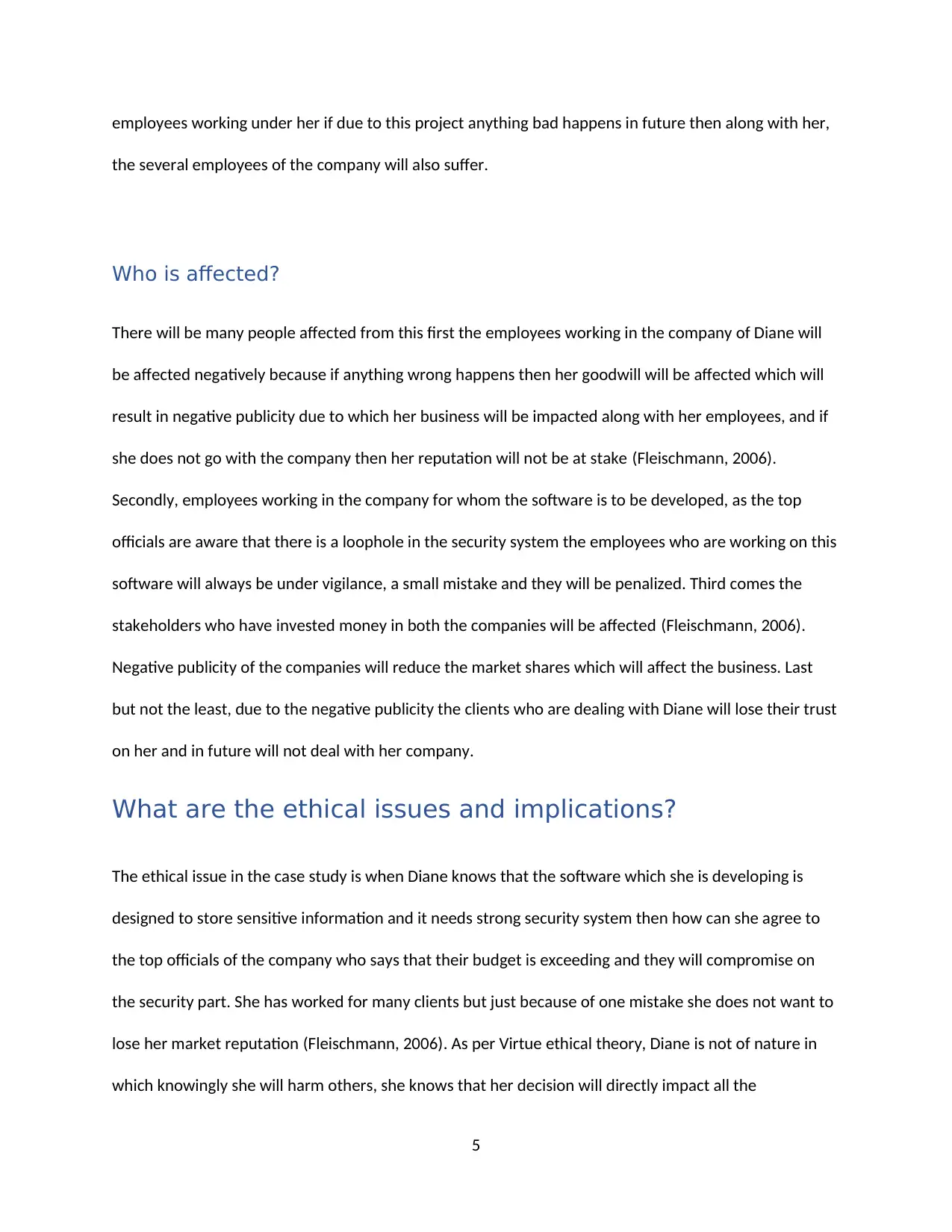
employees working under her if due to this project anything bad happens in future then along with her,
the several employees of the company will also suffer.
Who is affected?
There will be many people affected from this first the employees working in the company of Diane will
be affected negatively because if anything wrong happens then her goodwill will be affected which will
result in negative publicity due to which her business will be impacted along with her employees, and if
she does not go with the company then her reputation will not be at stake (Fleischmann, 2006).
Secondly, employees working in the company for whom the software is to be developed, as the top
officials are aware that there is a loophole in the security system the employees who are working on this
software will always be under vigilance, a small mistake and they will be penalized. Third comes the
stakeholders who have invested money in both the companies will be affected (Fleischmann, 2006).
Negative publicity of the companies will reduce the market shares which will affect the business. Last
but not the least, due to the negative publicity the clients who are dealing with Diane will lose their trust
on her and in future will not deal with her company.
What are the ethical issues and implications?
The ethical issue in the case study is when Diane knows that the software which she is developing is
designed to store sensitive information and it needs strong security system then how can she agree to
the top officials of the company who says that their budget is exceeding and they will compromise on
the security part. She has worked for many clients but just because of one mistake she does not want to
lose her market reputation (Fleischmann, 2006). As per Virtue ethical theory, Diane is not of nature in
which knowingly she will harm others, she knows that her decision will directly impact all the
5
the several employees of the company will also suffer.
Who is affected?
There will be many people affected from this first the employees working in the company of Diane will
be affected negatively because if anything wrong happens then her goodwill will be affected which will
result in negative publicity due to which her business will be impacted along with her employees, and if
she does not go with the company then her reputation will not be at stake (Fleischmann, 2006).
Secondly, employees working in the company for whom the software is to be developed, as the top
officials are aware that there is a loophole in the security system the employees who are working on this
software will always be under vigilance, a small mistake and they will be penalized. Third comes the
stakeholders who have invested money in both the companies will be affected (Fleischmann, 2006).
Negative publicity of the companies will reduce the market shares which will affect the business. Last
but not the least, due to the negative publicity the clients who are dealing with Diane will lose their trust
on her and in future will not deal with her company.
What are the ethical issues and implications?
The ethical issue in the case study is when Diane knows that the software which she is developing is
designed to store sensitive information and it needs strong security system then how can she agree to
the top officials of the company who says that their budget is exceeding and they will compromise on
the security part. She has worked for many clients but just because of one mistake she does not want to
lose her market reputation (Fleischmann, 2006). As per Virtue ethical theory, Diane is not of nature in
which knowingly she will harm others, she knows that her decision will directly impact all the
5
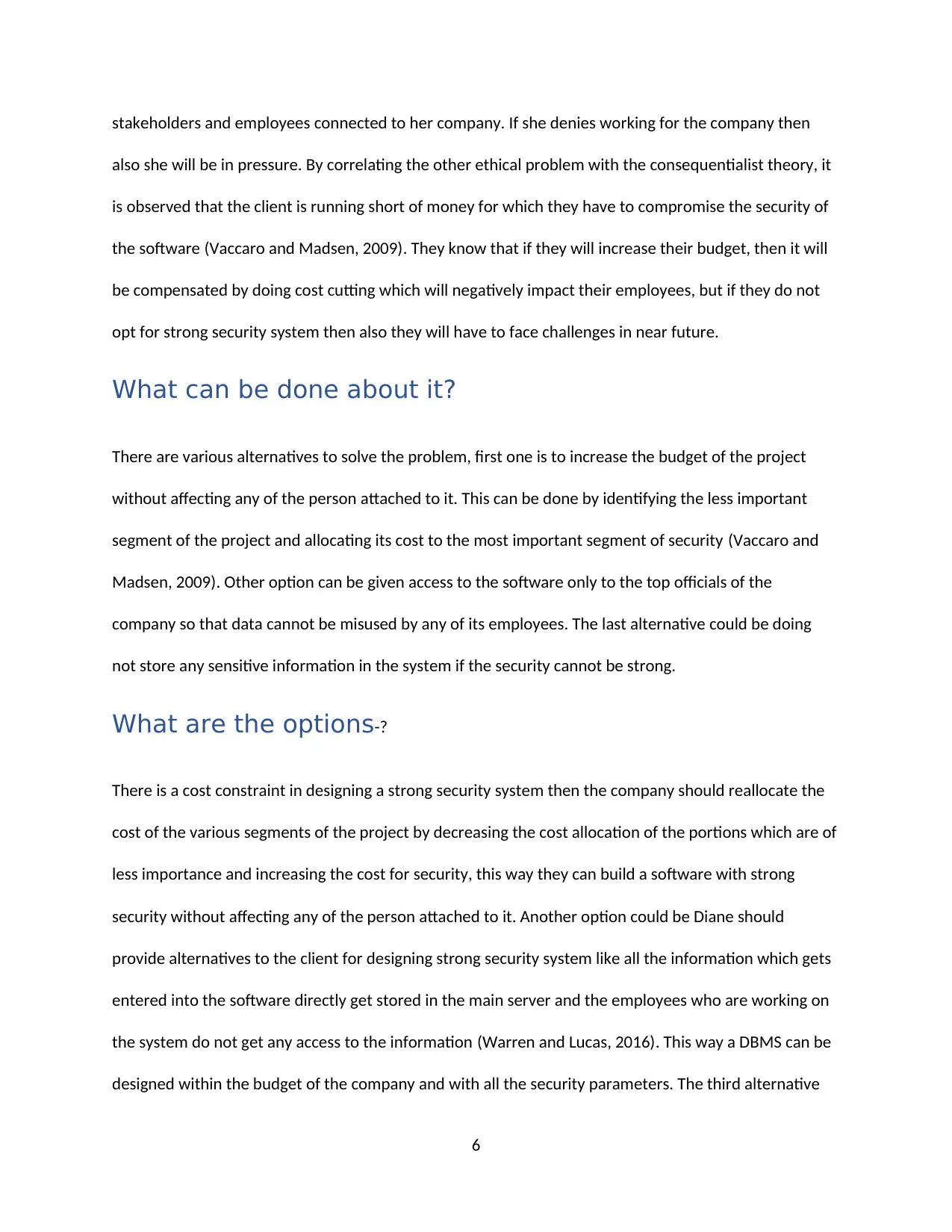
stakeholders and employees connected to her company. If she denies working for the company then
also she will be in pressure. By correlating the other ethical problem with the consequentialist theory, it
is observed that the client is running short of money for which they have to compromise the security of
the software (Vaccaro and Madsen, 2009). They know that if they will increase their budget, then it will
be compensated by doing cost cutting which will negatively impact their employees, but if they do not
opt for strong security system then also they will have to face challenges in near future.
What can be done about it?
There are various alternatives to solve the problem, first one is to increase the budget of the project
without affecting any of the person attached to it. This can be done by identifying the less important
segment of the project and allocating its cost to the most important segment of security (Vaccaro and
Madsen, 2009). Other option can be given access to the software only to the top officials of the
company so that data cannot be misused by any of its employees. The last alternative could be doing
not store any sensitive information in the system if the security cannot be strong.
What are the options-?
There is a cost constraint in designing a strong security system then the company should reallocate the
cost of the various segments of the project by decreasing the cost allocation of the portions which are of
less importance and increasing the cost for security, this way they can build a software with strong
security without affecting any of the person attached to it. Another option could be Diane should
provide alternatives to the client for designing strong security system like all the information which gets
entered into the software directly get stored in the main server and the employees who are working on
the system do not get any access to the information (Warren and Lucas, 2016). This way a DBMS can be
designed within the budget of the company and with all the security parameters. The third alternative
6
also she will be in pressure. By correlating the other ethical problem with the consequentialist theory, it
is observed that the client is running short of money for which they have to compromise the security of
the software (Vaccaro and Madsen, 2009). They know that if they will increase their budget, then it will
be compensated by doing cost cutting which will negatively impact their employees, but if they do not
opt for strong security system then also they will have to face challenges in near future.
What can be done about it?
There are various alternatives to solve the problem, first one is to increase the budget of the project
without affecting any of the person attached to it. This can be done by identifying the less important
segment of the project and allocating its cost to the most important segment of security (Vaccaro and
Madsen, 2009). Other option can be given access to the software only to the top officials of the
company so that data cannot be misused by any of its employees. The last alternative could be doing
not store any sensitive information in the system if the security cannot be strong.
What are the options-?
There is a cost constraint in designing a strong security system then the company should reallocate the
cost of the various segments of the project by decreasing the cost allocation of the portions which are of
less importance and increasing the cost for security, this way they can build a software with strong
security without affecting any of the person attached to it. Another option could be Diane should
provide alternatives to the client for designing strong security system like all the information which gets
entered into the software directly get stored in the main server and the employees who are working on
the system do not get any access to the information (Warren and Lucas, 2016). This way a DBMS can be
designed within the budget of the company and with all the security parameters. The third alternative
6
⊘ This is a preview!⊘
Do you want full access?
Subscribe today to unlock all pages.

Trusted by 1+ million students worldwide
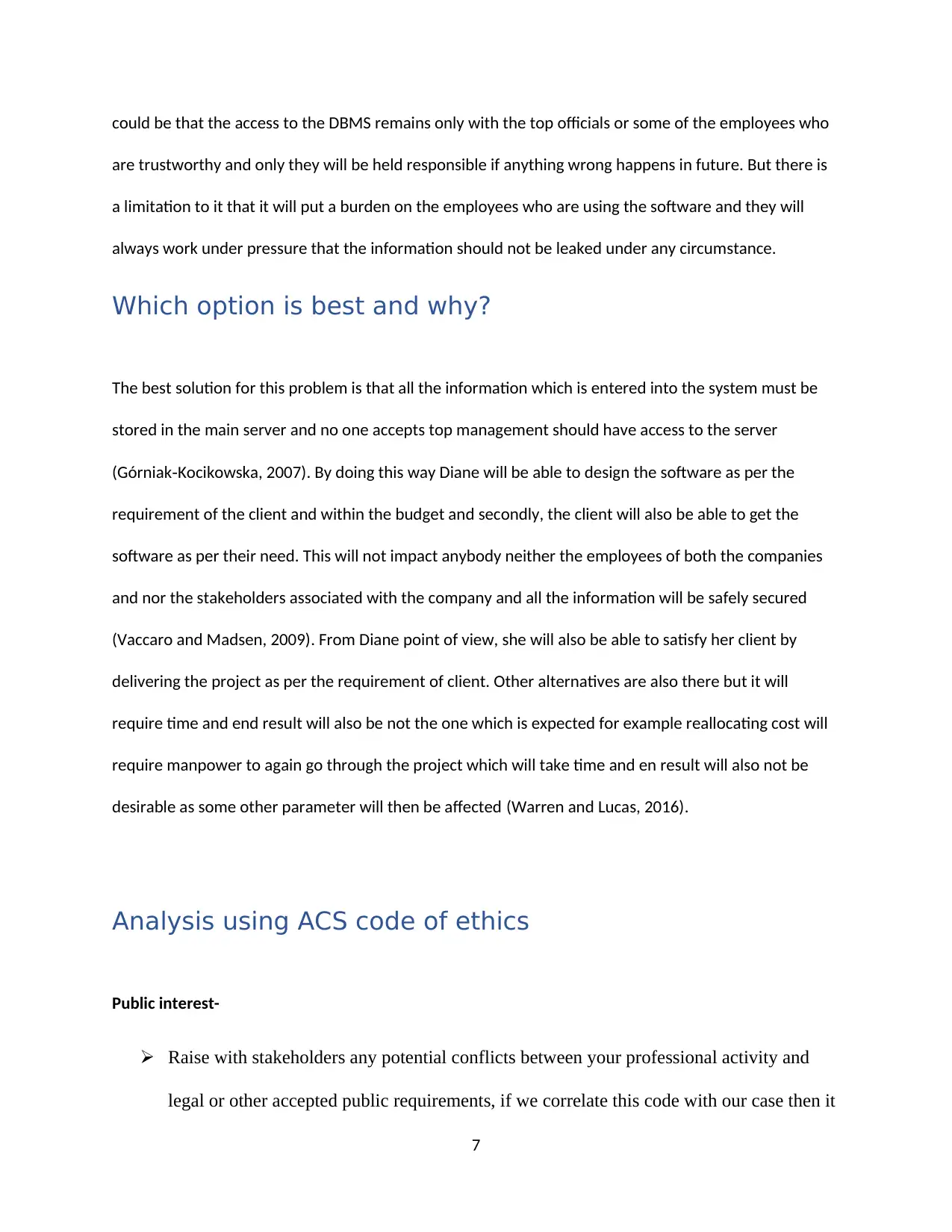
could be that the access to the DBMS remains only with the top officials or some of the employees who
are trustworthy and only they will be held responsible if anything wrong happens in future. But there is
a limitation to it that it will put a burden on the employees who are using the software and they will
always work under pressure that the information should not be leaked under any circumstance.
Which option is best and why?
The best solution for this problem is that all the information which is entered into the system must be
stored in the main server and no one accepts top management should have access to the server
(Górniak‐Kocikowska, 2007). By doing this way Diane will be able to design the software as per the
requirement of the client and within the budget and secondly, the client will also be able to get the
software as per their need. This will not impact anybody neither the employees of both the companies
and nor the stakeholders associated with the company and all the information will be safely secured
(Vaccaro and Madsen, 2009). From Diane point of view, she will also be able to satisfy her client by
delivering the project as per the requirement of client. Other alternatives are also there but it will
require time and end result will also be not the one which is expected for example reallocating cost will
require manpower to again go through the project which will take time and en result will also not be
desirable as some other parameter will then be affected (Warren and Lucas, 2016).
Analysis using ACS code of ethics
Public interest-
Raise with stakeholders any potential conflicts between your professional activity and
legal or other accepted public requirements, if we correlate this code with our case then it
7
are trustworthy and only they will be held responsible if anything wrong happens in future. But there is
a limitation to it that it will put a burden on the employees who are using the software and they will
always work under pressure that the information should not be leaked under any circumstance.
Which option is best and why?
The best solution for this problem is that all the information which is entered into the system must be
stored in the main server and no one accepts top management should have access to the server
(Górniak‐Kocikowska, 2007). By doing this way Diane will be able to design the software as per the
requirement of the client and within the budget and secondly, the client will also be able to get the
software as per their need. This will not impact anybody neither the employees of both the companies
and nor the stakeholders associated with the company and all the information will be safely secured
(Vaccaro and Madsen, 2009). From Diane point of view, she will also be able to satisfy her client by
delivering the project as per the requirement of client. Other alternatives are also there but it will
require time and end result will also be not the one which is expected for example reallocating cost will
require manpower to again go through the project which will take time and en result will also not be
desirable as some other parameter will then be affected (Warren and Lucas, 2016).
Analysis using ACS code of ethics
Public interest-
Raise with stakeholders any potential conflicts between your professional activity and
legal or other accepted public requirements, if we correlate this code with our case then it
7
Paraphrase This Document
Need a fresh take? Get an instant paraphrase of this document with our AI Paraphraser
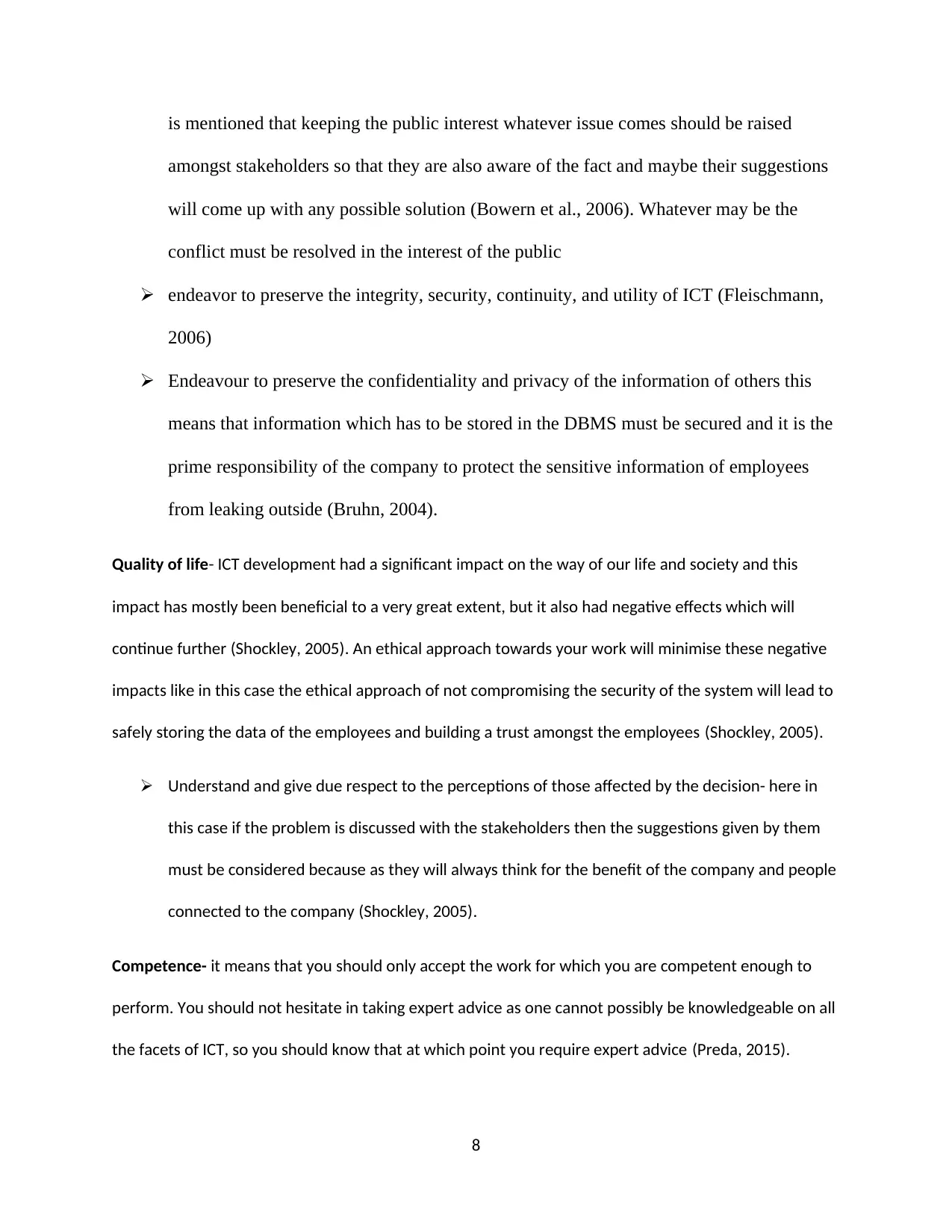
is mentioned that keeping the public interest whatever issue comes should be raised
amongst stakeholders so that they are also aware of the fact and maybe their suggestions
will come up with any possible solution (Bowern et al., 2006). Whatever may be the
conflict must be resolved in the interest of the public
endeavor to preserve the integrity, security, continuity, and utility of ICT (Fleischmann,
2006)
Endeavour to preserve the confidentiality and privacy of the information of others this
means that information which has to be stored in the DBMS must be secured and it is the
prime responsibility of the company to protect the sensitive information of employees
from leaking outside (Bruhn, 2004).
Quality of life- ICT development had a significant impact on the way of our life and society and this
impact has mostly been beneficial to a very great extent, but it also had negative effects which will
continue further (Shockley, 2005). An ethical approach towards your work will minimise these negative
impacts like in this case the ethical approach of not compromising the security of the system will lead to
safely storing the data of the employees and building a trust amongst the employees (Shockley, 2005).
Understand and give due respect to the perceptions of those affected by the decision- here in
this case if the problem is discussed with the stakeholders then the suggestions given by them
must be considered because as they will always think for the benefit of the company and people
connected to the company (Shockley, 2005).
Competence- it means that you should only accept the work for which you are competent enough to
perform. You should not hesitate in taking expert advice as one cannot possibly be knowledgeable on all
the facets of ICT, so you should know that at which point you require expert advice (Preda, 2015).
8
amongst stakeholders so that they are also aware of the fact and maybe their suggestions
will come up with any possible solution (Bowern et al., 2006). Whatever may be the
conflict must be resolved in the interest of the public
endeavor to preserve the integrity, security, continuity, and utility of ICT (Fleischmann,
2006)
Endeavour to preserve the confidentiality and privacy of the information of others this
means that information which has to be stored in the DBMS must be secured and it is the
prime responsibility of the company to protect the sensitive information of employees
from leaking outside (Bruhn, 2004).
Quality of life- ICT development had a significant impact on the way of our life and society and this
impact has mostly been beneficial to a very great extent, but it also had negative effects which will
continue further (Shockley, 2005). An ethical approach towards your work will minimise these negative
impacts like in this case the ethical approach of not compromising the security of the system will lead to
safely storing the data of the employees and building a trust amongst the employees (Shockley, 2005).
Understand and give due respect to the perceptions of those affected by the decision- here in
this case if the problem is discussed with the stakeholders then the suggestions given by them
must be considered because as they will always think for the benefit of the company and people
connected to the company (Shockley, 2005).
Competence- it means that you should only accept the work for which you are competent enough to
perform. You should not hesitate in taking expert advice as one cannot possibly be knowledgeable on all
the facets of ICT, so you should know that at which point you require expert advice (Preda, 2015).
8
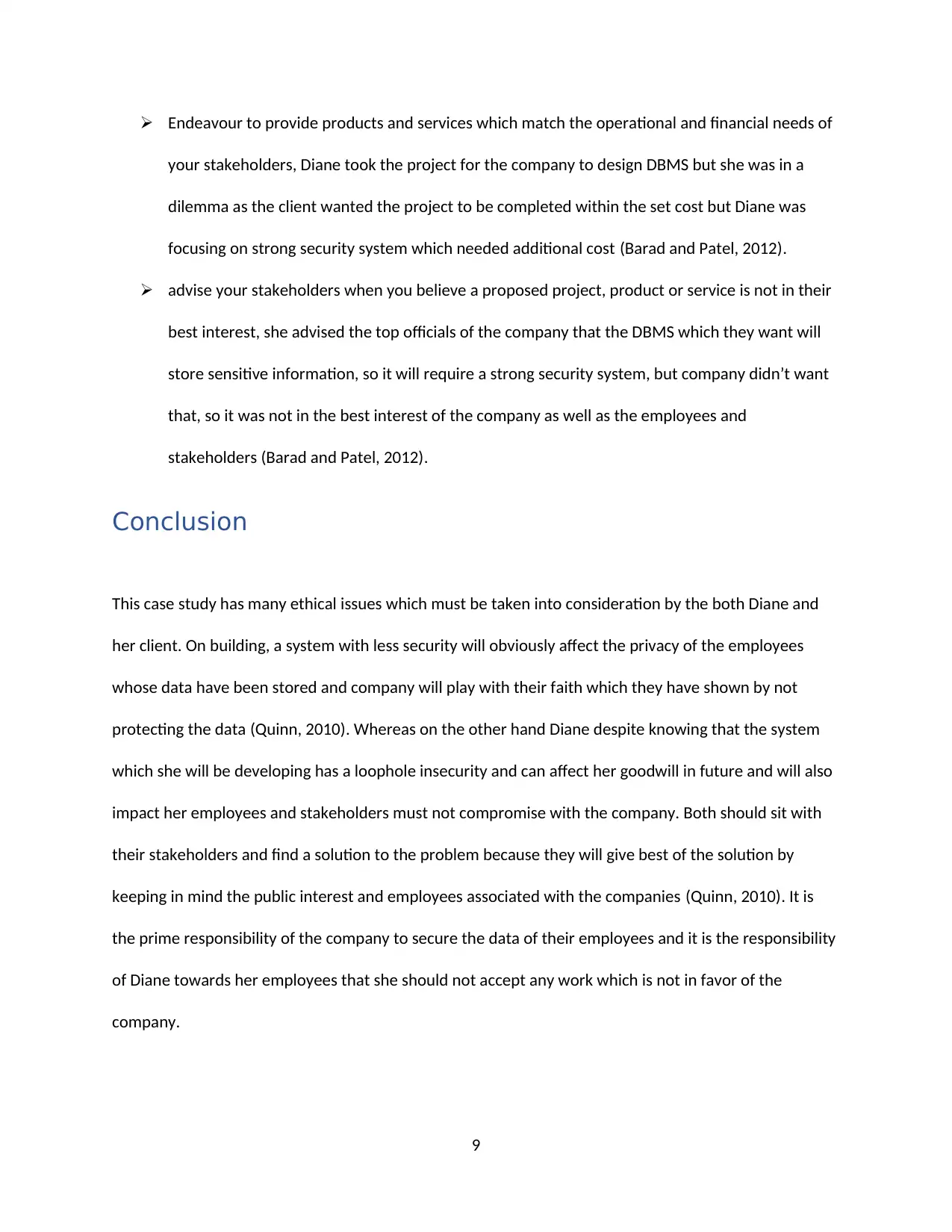
Endeavour to provide products and services which match the operational and financial needs of
your stakeholders, Diane took the project for the company to design DBMS but she was in a
dilemma as the client wanted the project to be completed within the set cost but Diane was
focusing on strong security system which needed additional cost (Barad and Patel, 2012).
advise your stakeholders when you believe a proposed project, product or service is not in their
best interest, she advised the top officials of the company that the DBMS which they want will
store sensitive information, so it will require a strong security system, but company didn’t want
that, so it was not in the best interest of the company as well as the employees and
stakeholders (Barad and Patel, 2012).
Conclusion
This case study has many ethical issues which must be taken into consideration by the both Diane and
her client. On building, a system with less security will obviously affect the privacy of the employees
whose data have been stored and company will play with their faith which they have shown by not
protecting the data (Quinn, 2010). Whereas on the other hand Diane despite knowing that the system
which she will be developing has a loophole insecurity and can affect her goodwill in future and will also
impact her employees and stakeholders must not compromise with the company. Both should sit with
their stakeholders and find a solution to the problem because they will give best of the solution by
keeping in mind the public interest and employees associated with the companies (Quinn, 2010). It is
the prime responsibility of the company to secure the data of their employees and it is the responsibility
of Diane towards her employees that she should not accept any work which is not in favor of the
company.
9
your stakeholders, Diane took the project for the company to design DBMS but she was in a
dilemma as the client wanted the project to be completed within the set cost but Diane was
focusing on strong security system which needed additional cost (Barad and Patel, 2012).
advise your stakeholders when you believe a proposed project, product or service is not in their
best interest, she advised the top officials of the company that the DBMS which they want will
store sensitive information, so it will require a strong security system, but company didn’t want
that, so it was not in the best interest of the company as well as the employees and
stakeholders (Barad and Patel, 2012).
Conclusion
This case study has many ethical issues which must be taken into consideration by the both Diane and
her client. On building, a system with less security will obviously affect the privacy of the employees
whose data have been stored and company will play with their faith which they have shown by not
protecting the data (Quinn, 2010). Whereas on the other hand Diane despite knowing that the system
which she will be developing has a loophole insecurity and can affect her goodwill in future and will also
impact her employees and stakeholders must not compromise with the company. Both should sit with
their stakeholders and find a solution to the problem because they will give best of the solution by
keeping in mind the public interest and employees associated with the companies (Quinn, 2010). It is
the prime responsibility of the company to secure the data of their employees and it is the responsibility
of Diane towards her employees that she should not accept any work which is not in favor of the
company.
9
⊘ This is a preview!⊘
Do you want full access?
Subscribe today to unlock all pages.

Trusted by 1+ million students worldwide
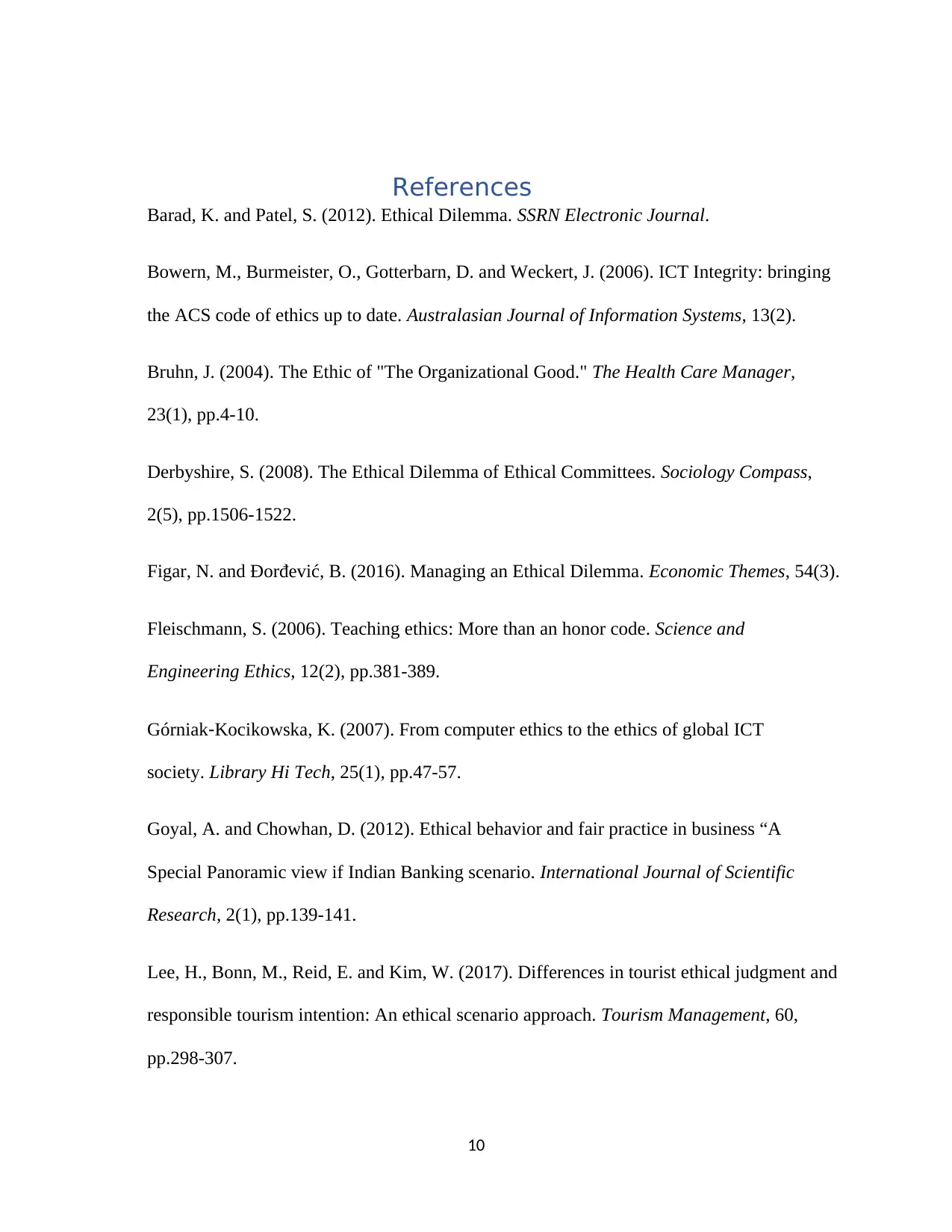
References
Barad, K. and Patel, S. (2012). Ethical Dilemma. SSRN Electronic Journal.
Bowern, M., Burmeister, O., Gotterbarn, D. and Weckert, J. (2006). ICT Integrity: bringing
the ACS code of ethics up to date. Australasian Journal of Information Systems, 13(2).
Bruhn, J. (2004). The Ethic of "The Organizational Good." The Health Care Manager,
23(1), pp.4-10.
Derbyshire, S. (2008). The Ethical Dilemma of Ethical Committees. Sociology Compass,
2(5), pp.1506-1522.
Figar, N. and Đorđević, B. (2016). Managing an Ethical Dilemma. Economic Themes, 54(3).
Fleischmann, S. (2006). Teaching ethics: More than an honor code. Science and
Engineering Ethics, 12(2), pp.381-389.
Górniak‐Kocikowska, K. (2007). From computer ethics to the ethics of global ICT
society. Library Hi Tech, 25(1), pp.47-57.
Goyal, A. and Chowhan, D. (2012). Ethical behavior and fair practice in business “A
Special Panoramic view if Indian Banking scenario. International Journal of Scientific
Research, 2(1), pp.139-141.
Lee, H., Bonn, M., Reid, E. and Kim, W. (2017). Differences in tourist ethical judgment and
responsible tourism intention: An ethical scenario approach. Tourism Management, 60,
pp.298-307.
10
Barad, K. and Patel, S. (2012). Ethical Dilemma. SSRN Electronic Journal.
Bowern, M., Burmeister, O., Gotterbarn, D. and Weckert, J. (2006). ICT Integrity: bringing
the ACS code of ethics up to date. Australasian Journal of Information Systems, 13(2).
Bruhn, J. (2004). The Ethic of "The Organizational Good." The Health Care Manager,
23(1), pp.4-10.
Derbyshire, S. (2008). The Ethical Dilemma of Ethical Committees. Sociology Compass,
2(5), pp.1506-1522.
Figar, N. and Đorđević, B. (2016). Managing an Ethical Dilemma. Economic Themes, 54(3).
Fleischmann, S. (2006). Teaching ethics: More than an honor code. Science and
Engineering Ethics, 12(2), pp.381-389.
Górniak‐Kocikowska, K. (2007). From computer ethics to the ethics of global ICT
society. Library Hi Tech, 25(1), pp.47-57.
Goyal, A. and Chowhan, D. (2012). Ethical behavior and fair practice in business “A
Special Panoramic view if Indian Banking scenario. International Journal of Scientific
Research, 2(1), pp.139-141.
Lee, H., Bonn, M., Reid, E. and Kim, W. (2017). Differences in tourist ethical judgment and
responsible tourism intention: An ethical scenario approach. Tourism Management, 60,
pp.298-307.
10
Paraphrase This Document
Need a fresh take? Get an instant paraphrase of this document with our AI Paraphraser
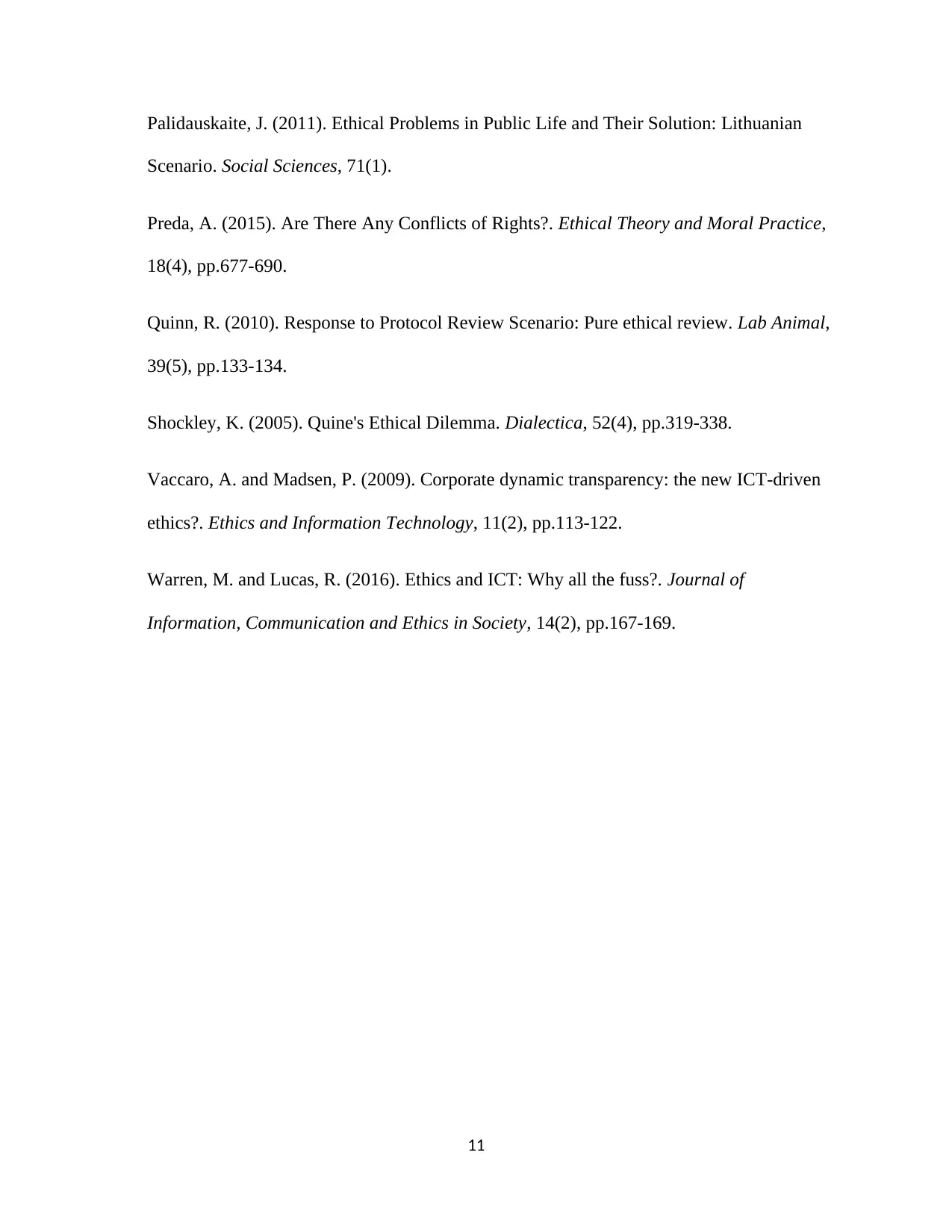
Palidauskaite, J. (2011). Ethical Problems in Public Life and Their Solution: Lithuanian
Scenario. Social Sciences, 71(1).
Preda, A. (2015). Are There Any Conflicts of Rights?. Ethical Theory and Moral Practice,
18(4), pp.677-690.
Quinn, R. (2010). Response to Protocol Review Scenario: Pure ethical review. Lab Animal,
39(5), pp.133-134.
Shockley, K. (2005). Quine's Ethical Dilemma. Dialectica, 52(4), pp.319-338.
Vaccaro, A. and Madsen, P. (2009). Corporate dynamic transparency: the new ICT-driven
ethics?. Ethics and Information Technology, 11(2), pp.113-122.
Warren, M. and Lucas, R. (2016). Ethics and ICT: Why all the fuss?. Journal of
Information, Communication and Ethics in Society, 14(2), pp.167-169.
11
Scenario. Social Sciences, 71(1).
Preda, A. (2015). Are There Any Conflicts of Rights?. Ethical Theory and Moral Practice,
18(4), pp.677-690.
Quinn, R. (2010). Response to Protocol Review Scenario: Pure ethical review. Lab Animal,
39(5), pp.133-134.
Shockley, K. (2005). Quine's Ethical Dilemma. Dialectica, 52(4), pp.319-338.
Vaccaro, A. and Madsen, P. (2009). Corporate dynamic transparency: the new ICT-driven
ethics?. Ethics and Information Technology, 11(2), pp.113-122.
Warren, M. and Lucas, R. (2016). Ethics and ICT: Why all the fuss?. Journal of
Information, Communication and Ethics in Society, 14(2), pp.167-169.
11
1 out of 11
Related Documents
Your All-in-One AI-Powered Toolkit for Academic Success.
+13062052269
info@desklib.com
Available 24*7 on WhatsApp / Email
![[object Object]](/_next/static/media/star-bottom.7253800d.svg)
Unlock your academic potential
Copyright © 2020–2025 A2Z Services. All Rights Reserved. Developed and managed by ZUCOL.





